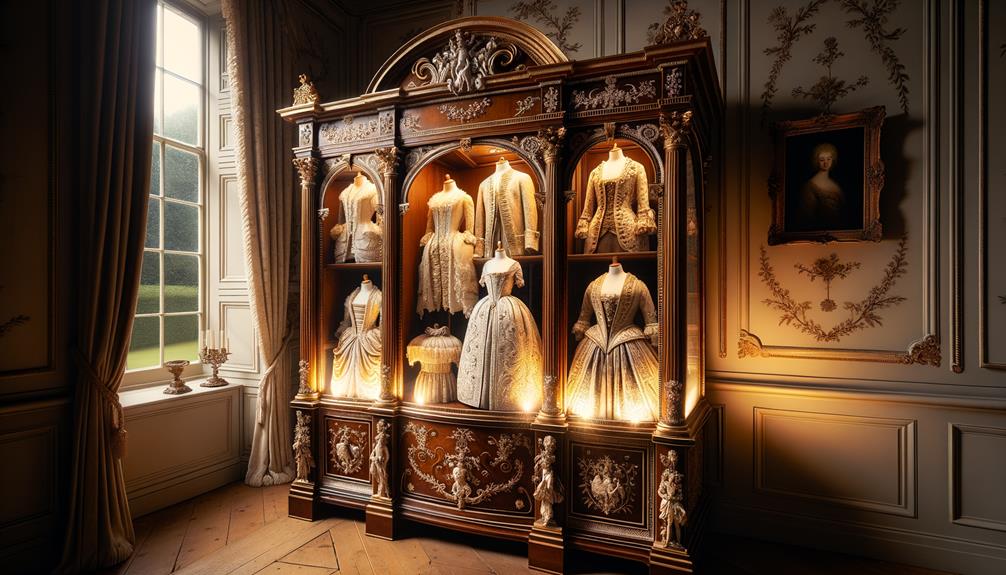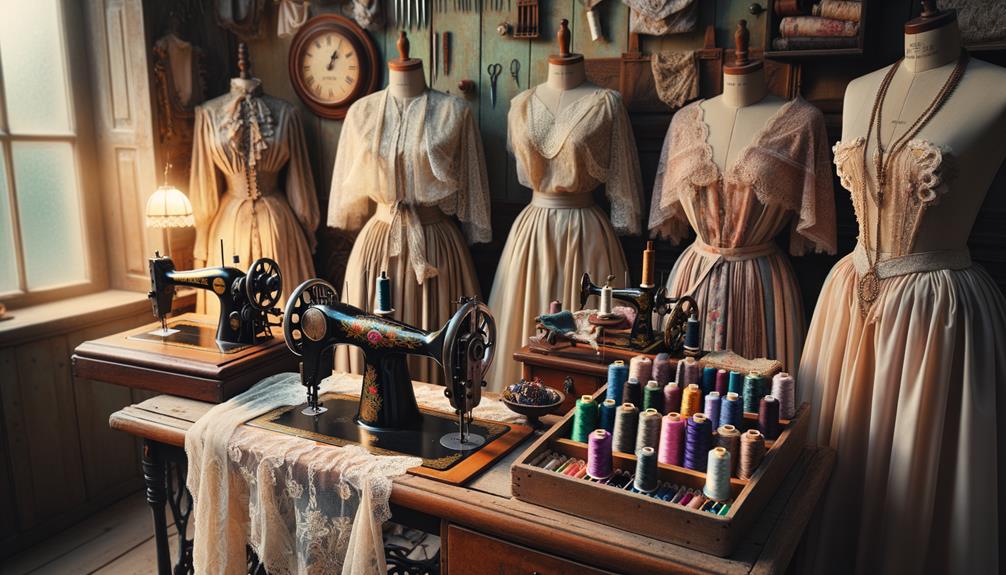Conserving antique leather accessories goes beyond just preservation – it's about honoring their historical charm and enduring beauty. Light, humidity, and temperature can threaten these delicate items, so I gently clean them with soft cloths and specialized solutions, avoiding harsh detergents. Conditioning the leather with lanolin-based products or Pecards Antique Leather Restorer helps revive its suppleness. For safe storage, I use cotton bags and acid-free tissue paper to protect their shape. Each piece requires careful handling, deep respect, and a touch of reverence. Uncovering the secrets of maintaining these treasures is a journey worth taking.
Understanding Leather Deterioration
There's a certain melancholy to watching antique leather slowly succumb to the passage of time. Each crack and crease tells a story, a whisper of days long past. As I hold these aged leather objects, I can almost hear the echoes of their vibrant histories. However, this poignant decay also brings a sense of urgency. Preserving leather isn't just about saving material; it's about safeguarding history.
Aged leather has a unique character, a patina that only years of use can bestow. Yet, it's this very aging process that poses the greatest challenge. Leather, being organic, is susceptible to a myriad of deteriorative forces – light, humidity, temperature fluctuations. Each element weaves its own narrative into the fabric of the leather, often hastening its decline. Understanding this deterioration is crucial in any conservation effort.
In my hands, I feel the delicate balance between preserving these treasures and respecting their natural aging process. It's a dance of science and art, requiring not just technical knowledge but an empathetic touch. By exploring the nuances of leather's slow fading, we can better honor its legacy while developing methods to extend its life.
Cleaning Antique Leather
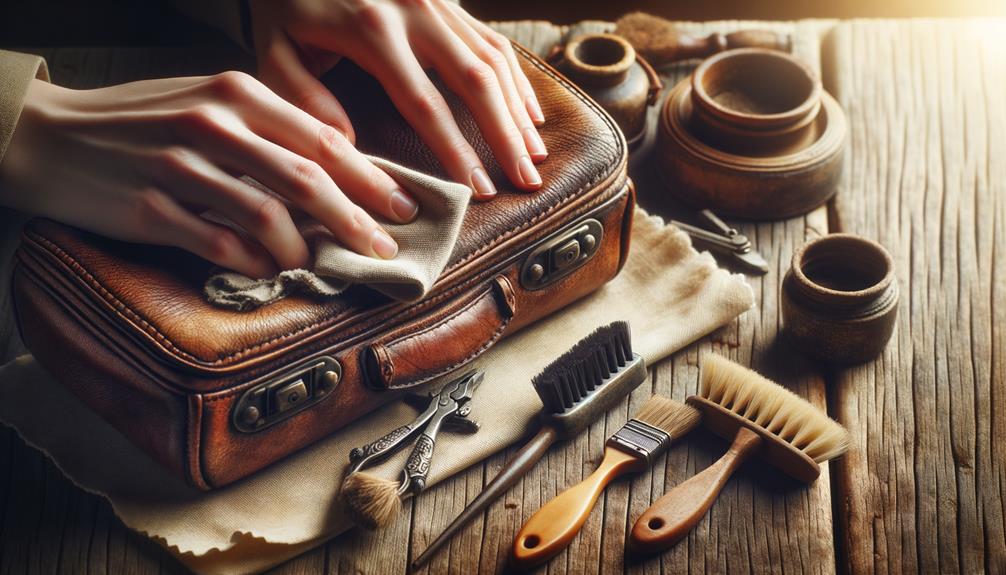
As I prepare to clean this antique leather, I can't help but think about how to best preserve its character while ensuring its longevity. Each piece has its own unique story, etched into the grain and patina. My approach to cleaning is not just a task, but a careful ritual of conservation that honors the leather's journey while protecting its future.
First, I avoid harsh detergents or soap, as they can strip the leather of its natural oils, leading to discoloration and deterioration. Instead, I opt for a gentler method:
- I use a soft, damp cloth to gently wipe the surface and remove surface dirt and dust, being mindful of the leather's delicate nature.
- For stubborn marks, I apply a small amount of specialized leather cleaner with a soft-bristle brush, working in circular motions to lift the grime without harming the material.
- Before committing to any cleaner, I always test it on an inconspicuous area to ensure it won't damage the leather.
- After cleaning, I allow the leather to fully air dry in a cool, well-ventilated area.
This meticulous process ensures each piece remains as timeless as its history.
Conditioning and Moisturizing
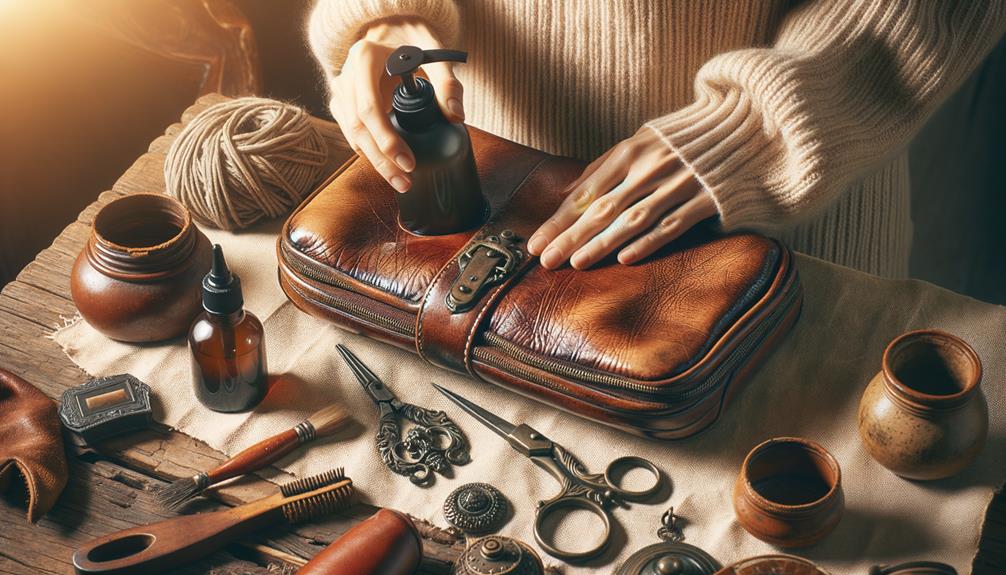
When I hold an old leather accessory, I sense its history and timeless charm. Choosing the right conditioner, like mink oil or neatsfoot oil, becomes an act of care, a way to revive its fibers. Applying it sparingly and evenly, I watch the leather come back to life, its surface softening as it absorbs the nourishing touch.
Choosing Appropriate Products
How often do we think about balancing preserving the past and nurturing its future, especially when it comes to caring for antique leather accessories? As I begin this journey of leather preservation, I'm guided by the whispers of history, urging me to choose products that honor the integrity of these timeless treasures.
The British Museum leather dressing has a reputation for carefully preserving artifacts that have stood the test of time. This dressing isn't just a product; it's a guardian of heritage.
Saddle soap, infused with lanolin, offers a gentle touch, restoring the suppleness and shine of antique leather without compromising its essence. It's a delicate balance, nourishing while preserving.
Pecards Antique Leather Restorer, with its lanolin-based formula, conditions without causing long-term harm. Beeswax, a natural waterproofing agent, revives and protects. Conservators Wax is effective for a variety of antique materials, including leather. Saddle Soap with Lanolin ensures suppleness and longevity.
In choosing these products, I'm not just maintaining leather; I'm weaving the past into the future, one thoughtful application at a time.
Applying Leather Conditioners
With my chosen leather care products on hand, the next step is to revive the leather through careful conditioning and moisturizing. Each vintage leather piece has a story to tell, and by using saddle soap, I begin the delicate process of cleansing the surface. This step is crucial, as it prepares the leather to absorb the nourishing conditioners I will soon apply.
I select a conditioner, perhaps neatsfoot oil or a silicone-based treatment, and test it on an inconspicuous area to ensure compatibility and avoid any unwanted discoloration. As I observe the leather's response, I can almost sense its relief as it drinks in the moisture and regains its lost suppleness.
Applying the conditioner in moderation, I gently massage it into the leather, taking care to reach every nook and cranny. This tender process not only softens and rehydrates but also fortifies the material, reducing the risk of cracking and brittleness. It's a delicate balance, as too little or too much can lead to issues like excessive oiliness and residue buildup, which would undermine the preservation of the leather.
Through this meticulous care, I can revitalize the damaged leather, ensuring its grace and elegance endure for future generations.
Safe Storage Practices
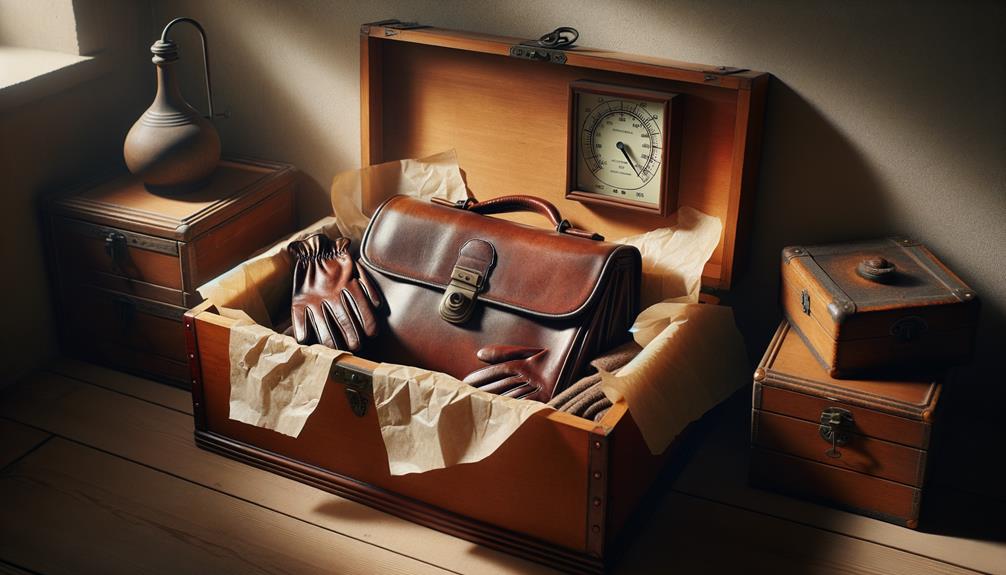
Properly storing antique leather accessories is crucial for preserving their beauty and longevity. Keeping these items in cotton bags or pillowcases allows the leather to breathe and avoids the damaging effects of airtight conditions. The natural aging process of these leather goods is part of their charm, but maintaining the right environment is key.
Controlling the humidity level is a vital step. A cool, dry place free from moisture, light, and temperature fluctuations will protect the leather from decay caused by humidity and heat.
To take care of these treasures, I follow a few simple practices:
- Stuffing bags and shoes with acid-free tissue paper or inserts helps maintain their shape and prevents sagging or distortion over time.
- Providing each piece its own space prevents scuffs, scratches, and bending of the form that can happen from overcrowding or stacking.
- Regular inspections allow me to spot and address any issues like mold, mildew, or signs of insects before they cause damage.
These steps help me preserve the beauty and character of my antique leather accessories, allowing them to age gracefully.
Repair and Restoration Techniques
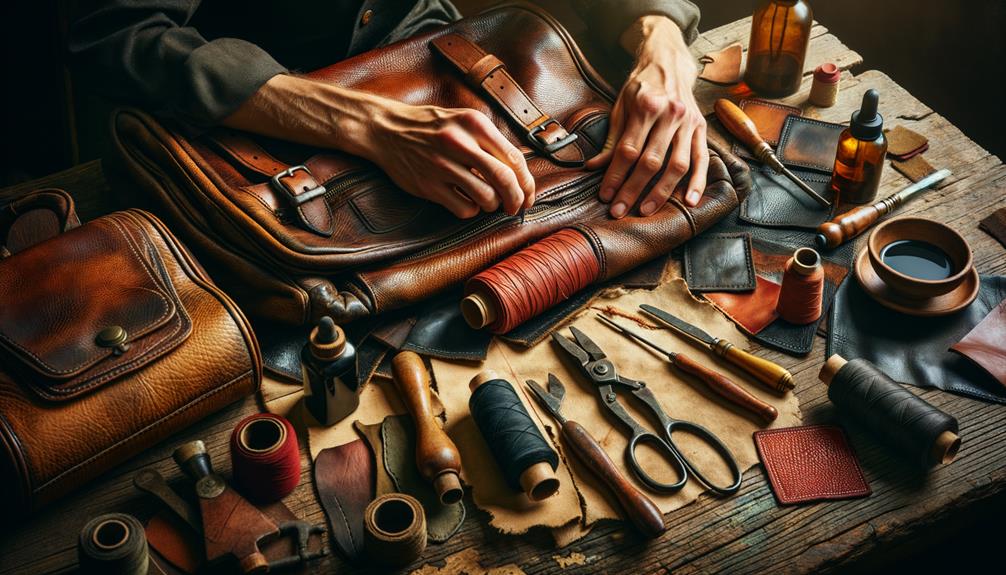
Restoring antique leather accessories is a delicate process that requires patience and skill. Each step aims to revive the timeless elegance of these items without erasing their storied past. At the heart of this craft lies an array of techniques, each chosen with utmost care to respect the integrity of the materials used. I always start with a patch test on an inconspicuous area, ensuring any restoration product blends seamlessly without causing harm.
The Canadian Conservation Institute emphasizes the importance of avoiding petroleum-based products like neatsfoot oil, which can, over time, make the leather brittle. Instead, I lean towards pH-neutral leather cleaners, applying them gently with a soft brush to cleanse without stripping away the essence of age.
In moments where the leather's wear demands more than a gentle touch, I consult with professional conservators. Their expertise guides me to the best course of action, ensuring that each technique is both safe and reversible. Proper storage then becomes my silent guardian, a cool, dry sanctuary with stable humidity levels, preserving the renewed beauty.
Through these methods, the past whispers through the present, the leather's tale continuing to unfold with grace and reverence.
Consulting Experts
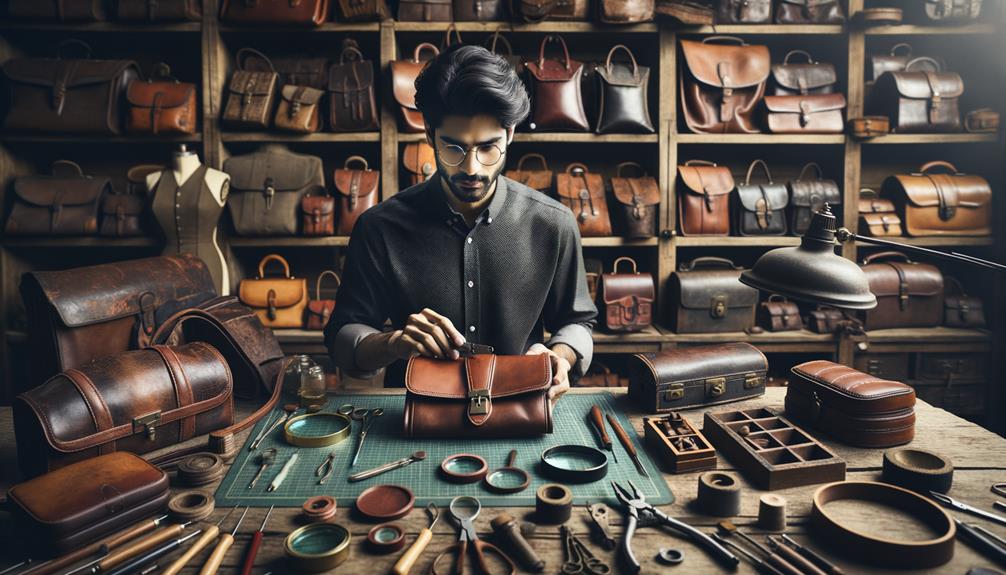
Consulting with experts can be incredibly valuable when caring for antique leather. Over the years, I've found that seeking guidance from professional conservators and experienced collectors has helped transform delicate relics into preserved masterpieces.
These experts offer invaluable insights:
- Expert Guidance: Conservators can advise on the best cleaning, conditioning, and storage methods to ensure the longevity of antique leather.
- Safe Techniques: Museum curators and historical society staff can share safe, reversible restoration techniques to avoid further damage.
- Specialized Products: Leather experts recommend specialized care products and proper application to protect the material.
- Traditional Practices: Experienced collectors or reenactors share time-tested preservation practices that have stood the test of time.
Connecting with the original makers, if possible, can also uncover the intended materials and maintenance methods for the piece. Each consultation weaves together the past and present, creating a tapestry of care that honors the essence of these antique treasures.
Frequently Asked Questions
How to Stabilize Old Leather?
To stabilize old leather, using pH-neutral conditioners is a gentle approach. Maintaining a humidity level between 45-55% is key. Harsh oils should be avoided, and the leather should be cared for with a light touch. For fragile pieces, it's best to seek guidance from a professional conservator.
How to Care for Antique Leather?
Caring for antique leather is an art. It requires maintaining stable humidity, handling it gently with cotton gloves, and using specialized cleaning tools with a light touch. Each stroke is a careful process, preserving the history and ensuring the timeless beauty of these treasures in cool, dark spaces.
How to Restore 100 Year Old Leather?
Restoring century-old leather requires a delicate touch. I'd gently clean it with a soft brush, nourish it with beeswax, and store it in a stable environment to keep it thriving like a cherished memory. The goal is to breathe new life into this forgotten artifact, preserving its history and character.
How Do You Nourish Old Leather?
Nourishing old leather is like breathing life into history. I gently massage beeswax or lanolin into the fibers, avoiding harsh chemicals. Each touch connects me to the leather's past, preserving its story for the future.
The process feels intimate, almost meditative. I'm mindful of each movement, carefully working the conditioning product into the worn material. It's as if I'm bringing back the vitality that time has slowly stripped away.
As I tend to the leather, I can't help but wonder about its origins and the hands that have handled it over the years. Was it part of a cherished family heirloom? Did it serve a practical purpose, like a well-worn satchel or a pair of sturdy boots? The leather holds those narratives, and I'm honored to be the one tasked with safeguarding them.
It's a delicate balance – respecting the leather's history while also ensuring its longevity. With each application of the nourishing treatment, I'm preserving a piece of the past, making sure it can continue to be enjoyed for years to come.
Conclusion
In my journey with antique leather, I've realized it's not just about preserving these items. It's about reviving the stories they hold – each crack and crease whispers secrets of a bygone era. By cleaning, conditioning, and properly storing these treasures, we honor their legacy. Repairing their worn parts feels like mending time itself. And sometimes, we need experts to guide us through the process. In caring for these relics, we don't just conserve the leather; we preserve the memories they represent.



